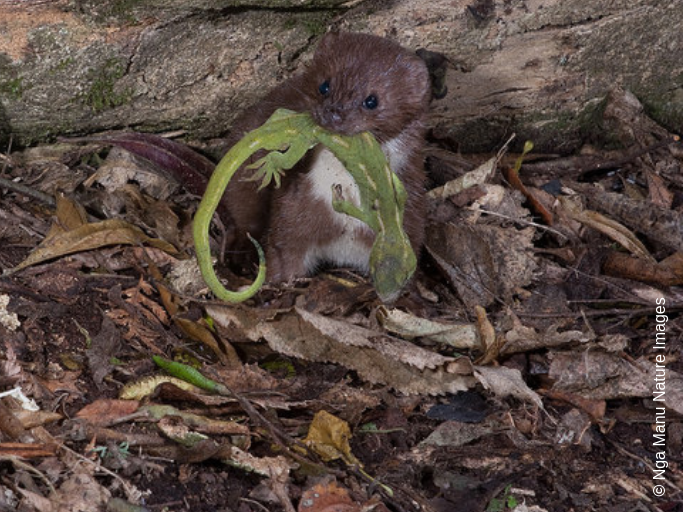ON THIS PAGE
How did they get here?
Weasels were introduced in the late 1800s, along with stoats and ferrets, to control the rabbit population. They quickly spread across the country.
For a while they were even protected by law (along with ferrets and stoats) because of their rabbit-controlling abilities. In 1936 the protection was finally lifted after protests that mustelids and feral cats were hunting game birds and poultry (see this article from Papers Past).
What do weasels look like?
Weasels are part of the mustelid family, along with stoats and ferrets.
Weasels are the smallest and least common mustelid. They have red/brown coats with white fur on their belly and a short tail. Weasels have a long, thin body with short legs. Adult weasels are about 20 – 25cm long.
Female weasels are much smaller than males. A female weasel can weigh up to 80g, but a male weighs up to 150g – so males are almost twice as big as females.

Where do they live?
Weasels are found in low numbers across NZ. They were introduced in large numbers but have not thrived. However, they still pose a threat to native wildlife.
They often live in gardens, farmland and scrub – probably because these are places where mice live. (Mice are their favourite food.)
What do we know about weasel behaviour?
Weasels hunt during the day and night.
Female weasels give birth to 4-6 young. Baby weasels grow very quickly and are good hunters by the time they are 8 weeks old.

What impact do they have?
Although mice are their favourite food, weasels also hunt birds and eat eggs, insects and lizards when they can’t find mice. They can kill an animal as big as a rabbit and carry it back to their den.
Weasels eat our native lizards and wētā. Studies of the weasel’s diet show that they probably eat lizards more often than stoats do. Fortunately, weasels aren’t as common in New Zealand as stoats.
How you can help control weasels
The most effective way to manage weasels is by regular and ongoing trapping.
- Buy an animal welfare approved weasel trap, such as the DOC 200 from our shop. Place traps along fencelines, hedges, stream banks, fallen logs or tree roots. Keep entrances clear of weeds or fallen leaves.
- Use eggs and/or fresh or salted rabbit as lures.
- Check the trap at least once a month and change the bait.
- Make sure you always wear gloves when handling your trap or catches.
View our trapping and baiting toolkit to ensure you get the best results.

